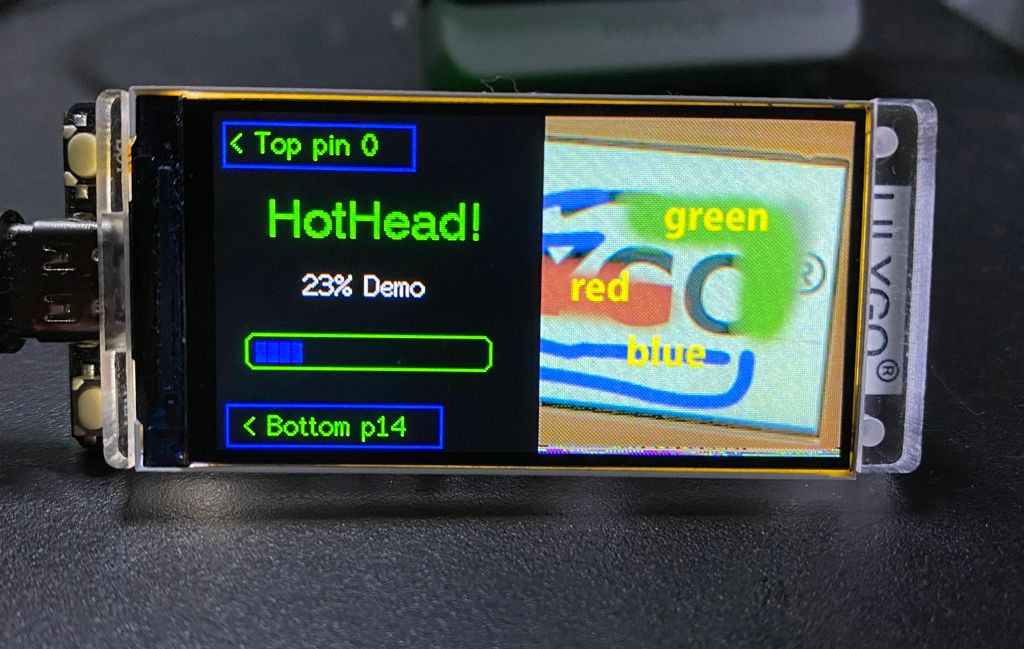@h5n1xp Hi!
I don't know if you've see this, but I have a support and setup guide that I made over on GurHub:
https://github.com/teastainGit/LilyGO-T-display-S3-setup-and-examples
Thanks for your support!
-Terry
teastain
@teastain
Retired Industrial Robotics Interface designer
Best posts made by teastain
-
RE: Turn off LEDs on the LILYGO T-Display S3posted in Technical Discussion
-
RE: ESP32-S3 TFT 1.9 displayposted in Product information
It is a bit more awkward, but you must confirm battery voltage during start up!
Your Lemon, may be the battery.
-
LilyGO T-Display S3 setup instructions and examplesposted in Common problems
I created a setup instruction for Arduino IDE and made two examples for LilyGO T-Display S3and posted them on GitHub here:
https://github.com/teastainGit/LillyGO-T-display-S3-setup-and-examples
Try it out and please let me know!
Terry -
RE: Turn off LEDs on the LILYGO T-Display S3posted in Technical Discussion
@roblatour Thanks! I know you would like to turn them off, but...
I submitted an Issue on their GitHub and got this response!
"Thank you for your support to lilygo. The gray WS2812 in the schematic does not exist in reality. There are two LED lights on the board, one is for charging indication (it will flicker when the battery is not connected, it will be always on when it is connected to charging, and it will be off in other states). The other one is connected to the same line as the backlight to be controlled together with the backlight."
I further tested and found these characteristics and posted it in my setup text:
<on-board LED colours and function:>
Green LED indicates board is powered up (Power Enabled) using either USB or Battery
Red LED indicates Board is powered up by USB only -
RE: Turn off LEDs on the LILYGO T-Display S3posted in Technical Discussion
@roblatour They are not well documented by LilyGO.
They are not user I/O, so you would have to blot them out with black paint.
I have studied the rather useless schematic provided and Red is USB power and Green is not documented. I have asked LilyGO for an updated or at least correct dwg.
-Terry
Latest posts made by teastain
-
RE: Setup for T-QT Pro Display is blackposted in Common problems
@ardymoon The LilyGO products are poorly supported, compared to M5Stack or Arduino.
You can go here:
https://github.com/Xinyuan-LilyGO/T-QT/issues
And start a new issue to get LilyGO support.I may have misspoken:
The LCD_BL may be active LOW, who knows?
On the LilyGO T-Display S3 it is active HIGH! -
RE: Setup for T-QT Pro Display is blackposted in Common problems
Can you check if your sketch does this:
#define PIN_LCD_BL 10
pinMode(PIN_LCD_BL, OUTPUT);
digitalWrite(PIN_LCD_BL, HIGH);Unbelievably their demo LCD.ino sketch turns this OFF at line 25.
I do not have a T-QT Pro to test but if this fixes it, I will file an issue in their repository against it.
-Terry -
RE: create c code for T-QT Pro img/logoposted in Common problems
@tavdog I saw Mickey closed your issue in LilyGO T-Display S3 repository ?
This is confusing because swap bytes is much like reversing a film negative in that it should change radically with swap bytes true or false.
Did you checkout my LilyGO T-Display S3 repository ?
[edit] I just did this test of your image on my LilyGO T-Display S3 !

point is that blue came out blue and red is red! -
RE: LilyGo-T-Relay change I2C pinsposted in Technical Discussion
@rogeriocpe said in LilyGo-T-Relay change I2C pins:
INA219
oof, OK. Can you draw out the circuit and post it, or email it to me at:
teastain@me.com -
RE: T-Display-S3: cannot upload a sketch #2posted in Common problems
Hmmm... not much to go on!
So I would recommend my GitHub Repository setup guide for LilyGO T-Display S3 here:
https://github.com/teastainGit/LilyGO-T-display-S3-setup-and-examples
My examples are simple stable demo programs to get up and running.
Let me know, Terry. -
RE: LilyGo-T-Relay change I2C pinsposted in Technical Discussion
@rogeriocpe As you probably know there does not seem to be a dedicated I2C port. Looking at the chip pinout here:
https://www.espressif.com/sites/default/files/documentation/esp32-wrover-b_datasheet_en.pdf
page 9, I would guess that GPIO 26 and 14 would work for I2C.
Maybe define them with wire.begin(26, 14);
I do not have a T-Relay to try this on!
Cheers, Terry -
RE: Turn off LEDs on the LILYGO T-Display S3posted in Technical Discussion
@h5n1xp Hi!
I don't know if you've see this, but I have a support and setup guide that I made over on GurHub:
https://github.com/teastainGit/LilyGO-T-display-S3-setup-and-examples
Thanks for your support!
-Terry -
RE: Using a Lilygo T-Display S3 with an external real time clockposted in Technical Discussion
@roblatour The JST beside the USB-C is SDA 43, SCL 44
https://github.com/teastainGit/LilyGO-T-display-S3-setup-and-examples/blob/main/T-DisplayS3_Pinout.png
Cheers, Terry -
RE: T-Display-S3: Can't flash large example projectsposted in Technical Discussion
@tebachi
As a hobbyist/maker I find Arduino a piece-of-cake and meets all of my needs.
PlatformIO and ESP-IDF looks like a huge pain in the ass!
Cheers, tho'! -
RE: T-Display-S3: Can't flash large example projectsposted in Technical Discussion
@tebachi
Hmmm... I use Arduino Ver 1.8.19 and it is stable, I can load all the projects.
I had a lot of trouble with the T-Display S3 initially with no support from LilyGO, so I made my own "New User" help desk Repository:
https://github.com/teastainGit/LilyGO-T-display-S3-setup-and-examples
Let me know if it helps!
-TerryP.S.
The S3 chips sometime (!) need the Boot Button GPIO0 to be pressed, while holding press the tiny black Reset button on the back and release only the Reset, then release the Boot.
(You may still have to unplug from USB and re-plug before it loads.)
very persnickety